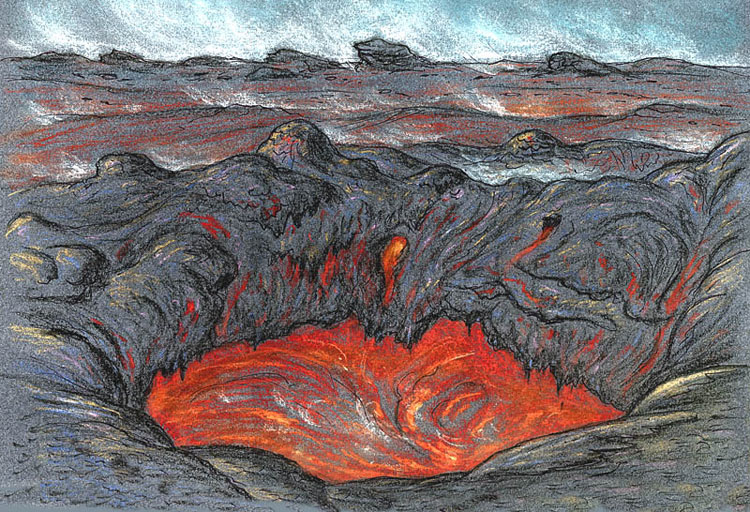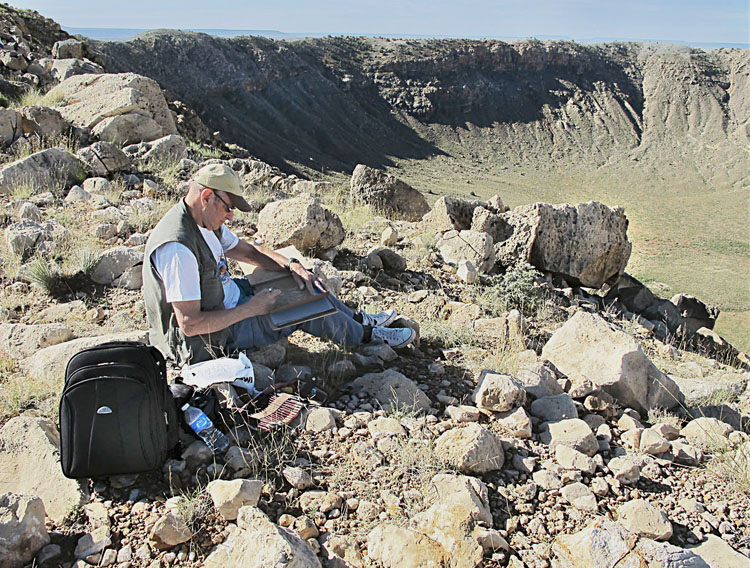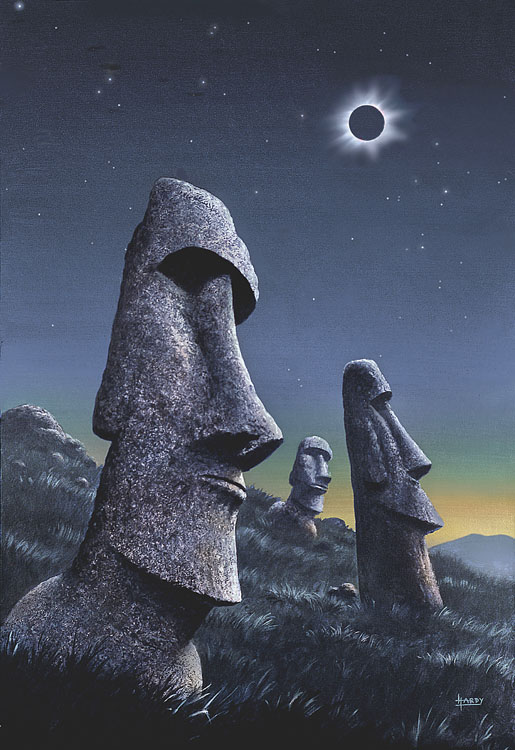Report
By David A. Hardy, FBIS, FIAAA
- Published: Monday, May 12 2014 21:47

Title: “Graben on Mars by David A. Hardy”
Caption: A scene of a graben on Mars with an approaching dust storm to add drama, and an invented robotic rover, painted in gouache as inspired by a scene in Iceland.
Until the 1980s I was aware of only a few living space artists. The great French astronomer/artist Lucien Rudaux had died in 1947; the British artist Ralph A. Smith, whom I met in the fifties, died in 1959; only the American Chesley Bonestell was alive until 1986, when he passed at 98. I had become aware of other artists and illustrators, all living in the United States, such as Don Davis, Don Dixon, Ron Miller and William K. Hartmann, and around 1970 the Czech artist Ludek Pesek came to prominence in the National Geographic, but in the UK I was effectively a “lone wolf.” It was in 1986 that I saw in the caption to an illustration of a planetary landscape in a magazine a mention of the “International Association of Astronomical Artists” (IAAA). There was an organization for space artists? No Internet existed in those days, but I managed to find out more details, and soon became a member. My illustrated book with Patrick Moore, Challenge of the Stars, had been published in 1972 in the UK and US and in a number of translations, so I quickly found that I was already well known “across the Pond” and welcomed!

Title: Thingvellir by David A. Hardy (1988)
Caption: The graben fault valley at Thingvellir, Iceland, sketched in pen and pastel. This formed the basis for the above painting of a probe exploring a similar geological formation on Mars.
From IAAA membership publications I discovered that there had been several workshops, the first being in Hawaii in 1982, followed by Death Valley in 1983 and Canyonlands in 1984. Following a visit by seven US artists to Moscow in 1987 for the Space Future Forum, 1988 saw the first fully international workshop, held in Iceland and attended by US, Soviet (as they then were) artists, a Canadian, and a British artist – myself. Thirty artists in all, but it quickly became obvious that the “western” artists generally had different ideas about astronomical art than their Russian counterparts. While we usually painted realistic and accurate impressions of how we envisaged scenes in space, the surface of the Moon and other planets etc., they seemed to place the emphasis more on the social and philosophical implications of “Man’s place in the Cosmos” than on the technical and scientific aspects. As a result, their art usually tended to be impressionistic, expressionistic, or abstract and non-representational, known within the IAAA as “swirly” art, while the more realistic work is called “rocks ‘n’ balls.”
It was in Iceland that the Canadian artist, Kara Szathmary, was elected the first international President of the IAAA; it was perhaps appropriate that Kara too generally produces a form of swirly art. Soon afterwards I became the first European Vice President – a position I hold again today. We soon began to attract members from other parts of Europe and the world and I was elected a Fellow of the organization. In 1996 I served a term as President, and in 2001 I received the Lucien Rudaux Memorial Award.
But meeting other like-minded artists for the first time in 1988 still holds a favorite place in my memory. Why was Iceland chosen? For one thing it was “neutral territory” for the various nationalities involved. But mainly, as with most workshops, Iceland represented an analogue of the terrain of several other worlds. It has giant volcanoes and fault valleys (graben), as does Mars. Venus also has shield volcanoes, and Jupiter’s moon Io is highly and actively volcanic. Iceland also has thermal areas, or solfataras, such as the well-known ones at Geysir (from where the word “geyser” comes) and the hot springs and fumaroles of Namaskard. Another artist and I climbed right up into the crater of the volcano Krafla, where we were rewarded for our efforts by seeing the solfatara of Leihrjúkur, its bubbling mud pots shrouded in steam and one of the weirdest and atmospheric places I have ever visited.

Title: Hawaii Lava Sketch by David A. Hardy
Caption: A pastel-and-ink sketch made in Hawaii in 1991. Hardy saw a skylight – a view of lava flowing through an underground tube, seen through a hole in its roof – from a helicopter flying over Kilauea, and later sketched this, showing it as it would have looked when being formed.
Most space artists would love to go into space, but since we can’t, such “alien” places on Planet Earth are the next-best thing. In 1989 a group of western and Soviet artists visited the Jet Propulsion Laboratory in Pasadena to view the images coming in from Voyager 2 as it made its fly-by of Neptune and its large moon Triton. We were among the first to see Neptune’s Great Dark Spot (as opposed to Jupiter’s Great Red Spot), and the strange long dark streaks on the pink methane ice of Triton, which proved to be caused by geysers that propelled material many kilometers above the surface, that then drifted down to form the streaks. We went on to the US southwest for the second workshop to be held in Canyonlands and Arches National Park, based on a ranch in Moab. Here again, the red-rock landscapes were useful reference material and reminders of Mars, and especially the Valles Marineris. I have now attended over a dozen workshops; we sketch, paint, take photos and videos, critique, exchange ideas, tips and hints, and generally have fun!

Caption: Photo of Hardy sketching at Meteor Crater, Arizona, taken by fellow artist Tim Malles in 2011. Other artists were scattered around the rocks, with easels, sketchpads, iPads and cameras.
My own next IAAA workshop was on the big island of Hawaii in July 1991, timed to coincide with a total solar eclipse. Hawaii is again volcanic, and most of its volcanic peaks are of the “shield” type – as are those on Venus and Mars, but these are much bigger than Mauna Kea. This means that instead of the archetypal tall conical shape they are broad, convex and relatively flat, though occupying a huge area. The weather was clear and sunny, with blue skies at 7:30am – until the day of the eclipse, when the island was “socked in” by cloud. It turned out that 98% of the people there saw nothing but cloud, but we were lucky: at the moment of eclipse, before which we could easily see the shape of the Sun becoming a thinner and thinner crescent, the clouds parted sufficiently for us to see totality. This being my first eclipse it was a magical experience. I have now seen six, including Chile, the Sahara and the Pacific Island of Hao, prior to going on to Easter Island. Although I obviously knew the cause of “the Sun going out”, the sight of that strange black hole in the sky, the tentacles of its corona appearing to ripple due to thin cloud drifting across it, seemed to trigger some sort of primeval response in my brain which was telling me, “This isn’t right – run into your cave and hide!” I recommend seeing a total solar eclipse to anyone, especially to astronomers. Photographs and video cannot do them justice; it is not until you see one with your own eyes that you know why some people travel thousands of miles just to chase them!
David A. Hardy is European Vice President of the International Association of Astronomical Artists (IAAA).

Title: Easter Island Eclipse by David A. Hardy
Caption: Although he did not actually see the 2010 eclipse from Easter Island, but from the Pacific atoll of Hao, Hardy did go to Easter Island, and painted this scene as it would have appeared. (Acrylics/digital)








Comments